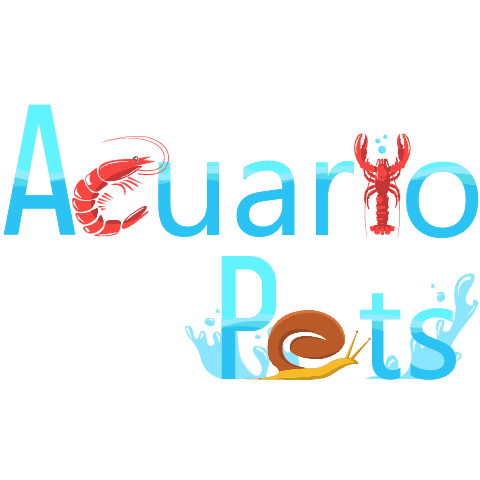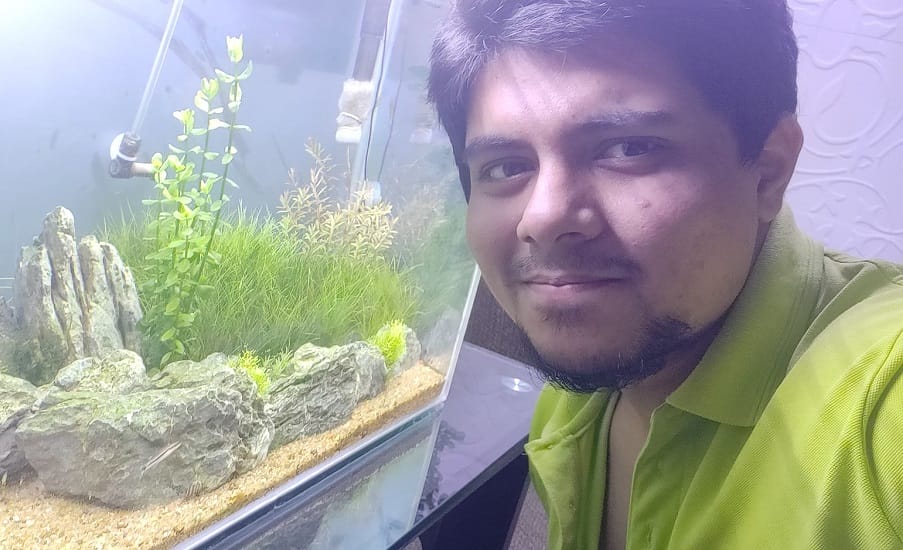This post was created with help from AI tools and carefully reviewed by a human (Muntaseer Rahman) . For more on how we use AI on this site, check out our Editorial Policy.
Check Out These FREE Tools We Made JUST For You!
How To Know If Your Leopard Gecko Is Hungry?
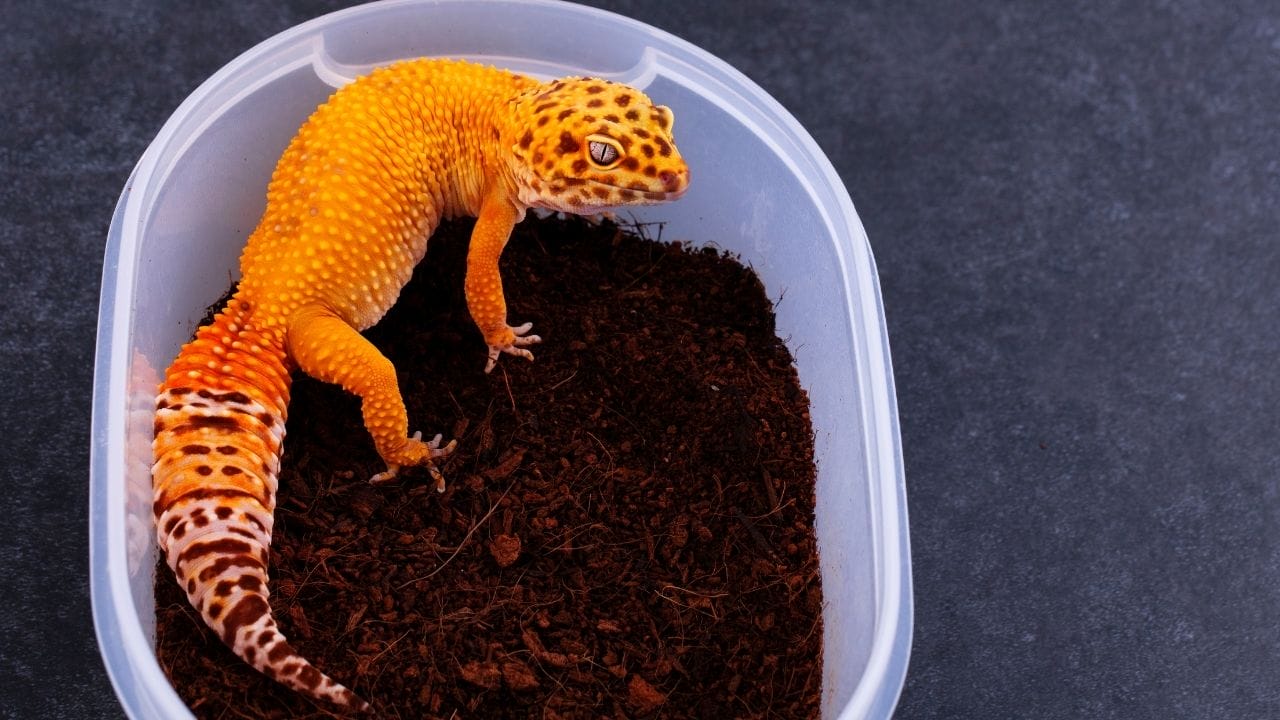
The first time I saw my leopard gecko pacing back and forth like a tiny, determined lizard on a mission, I had no idea he was trying to tell me something.
Turns out, he was starving—and I’d totally missed the signs.
If you’ve ever stared into those wide, unblinking eyes and wondered what they’re really trying to say, this guide is for you.
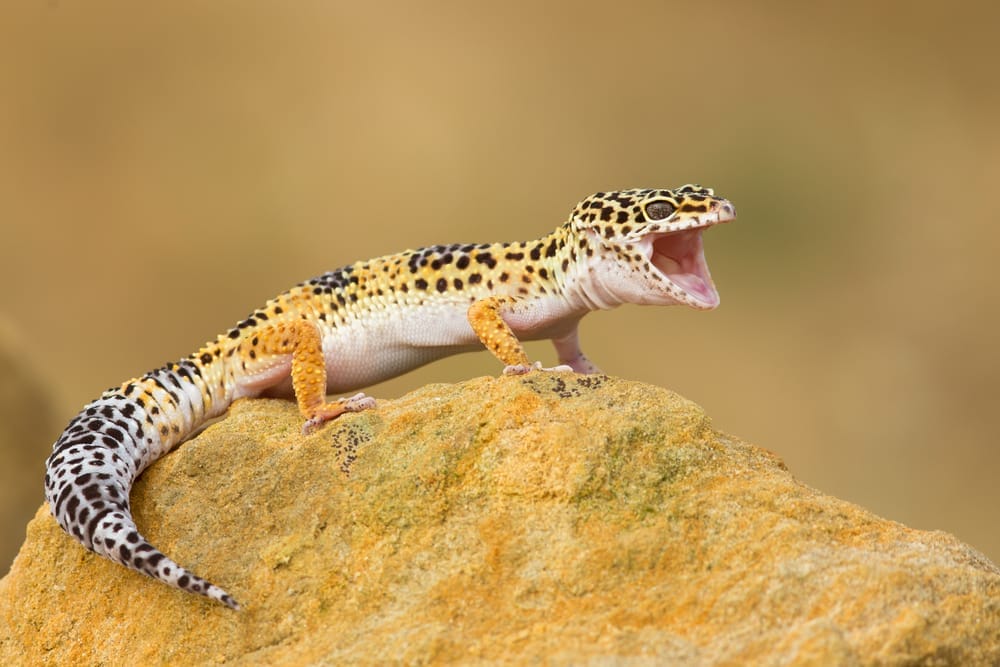
Common Signs Your Leopard Gecko Is Hungry
They Get Super Active
If your gecko was chilling all day and suddenly starts moving like it’s on a mission, that’s a red flag.
- Pacing back and forth
- Climbing the glass
- Roaming around the tank nonstop
They’re not doing cardio for fun. They’re looking for food.
Tongue Flicking and Sniffing Everything
Hungry geckos go into detective mode.
- They flick their tongue near the food bowl
- Sniff the usual feeding spots
- Hang around the same area where you usually drop insects
Basically, they’re saying, “Where’s the snack?”
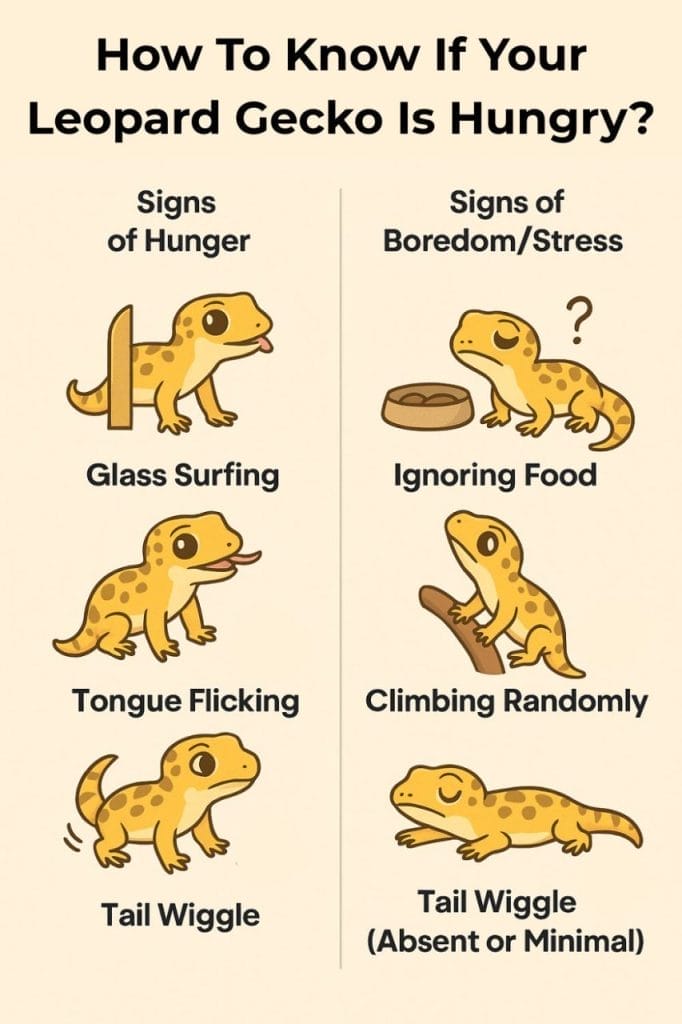
Hunting Even When There’s No Prey
You might see them:
- Crouch low like they’re about to pounce
- Wiggle their tail in that slow-motion predator style
- Freeze and stare into nothing like a lizard ninja
That’s classic “I’m hungry” behavior. They’re mentally chasing something.
Staring At You Like You Owe Them Food
Sometimes they’ll just sit and watch you.
- Following your movements
- Pressing their little face against the glass
- Acting like you’re a giant walking cricket
They’re trying to guilt-trip you. And it usually works.
When you start seeing these signs, it’s feeding time. Don’t keep them waiting—no one likes a hangry gecko.
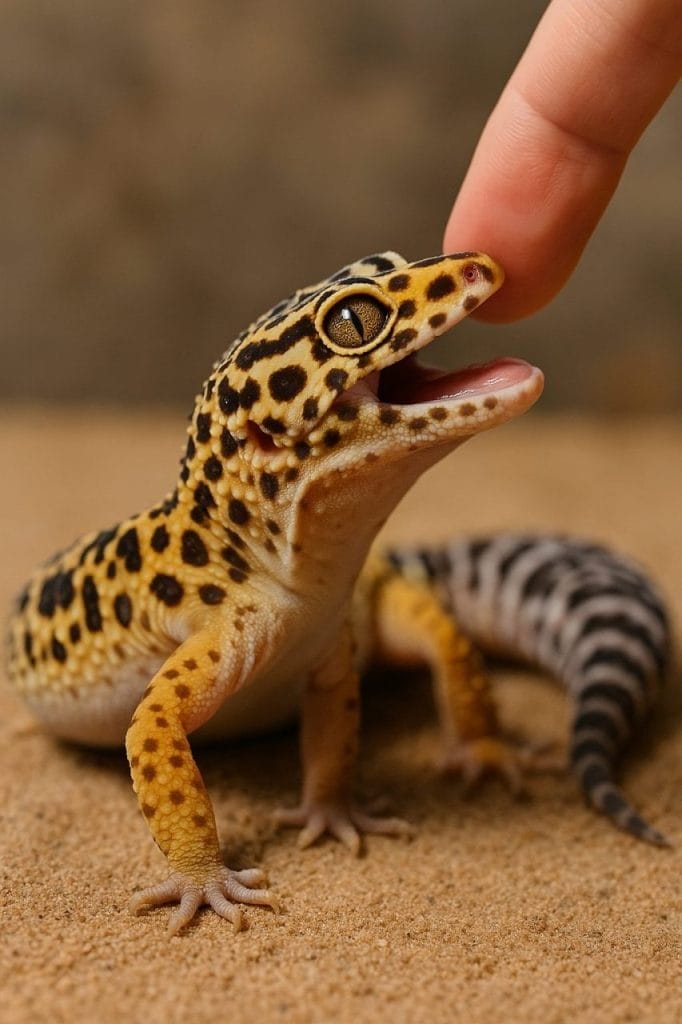
How Often Should You Feed a Leopard Gecko?
Feeding your gecko isn’t guesswork—there’s a rhythm to it. How often they eat depends mostly on age, size, and whether they’re still growing.
Here’s a quick cheat sheet:
| Age | Feeding Frequency | Notes |
|---|---|---|
| 0–6 months | Daily | Let them eat freely in 15 mins |
| 6–12 months | Daily or every other day | Watch their appetite shift |
| 1 year + (adult) | 2–3 times a week | Smaller portions, keep variety |
Babies Eat Like Tiny Monsters
If your gecko is under 6 months old, they’re growing fast and need fuel.
- Feed once a day
- Offer small crickets, mealworms, or dubia roaches
- Let them eat as much as they want in 15 minutes
They’re basically bottomless pits with tails.
Juveniles Still Eat A Lot
From 6 to 12 months, they slow down a little, but not much.
- Feed every day or every other day
- Keep offering a mix of live bugs
- Start watching how much they’re eating—some might start getting picky
This is when you’ll notice them going from “eat everything” to “meh, not feeling worms today.”
Adults Don’t Need Daily Meals
Once they hit a year old, things change.
- Feed 2 to 3 times a week
- Offer fewer bugs, but make sure they’re gut-loaded
- Keep portions reasonable to avoid making them chunky
They’re not growing anymore, just maintaining. Think lizard meal-prep life.
Don’t Forget the Calcium
No matter the age, always:
- Dust the bugs with calcium every other feeding
- Use a multivitamin once a week
Keeps their bones strong and prevents nasty issues like MBD.

Signs Your Gecko Is Not Hungry
Sometimes your gecko just isn’t feeling it—and that’s okay. But how do you tell if they’re full, stressed, or just not in the mood to eat?
Here are some clear signs:
They Ignore Live Food
You drop a juicy cricket in, and… nothing.
No chase, no tail wiggle, no interest at all.
- They might glance at it, then walk away
- Or just stay still like it’s not even there
If they’re usually a hunter and suddenly don’t care? Yeah, they’re not hungry.
Hiding Instead of Exploring
Hungry geckos get active.
If yours is tucked away in their hide, snoozing like a rock, they’re probably not in eating mode.
- Hiding all day
- Avoiding the warm area or food zone
- Barely reacting when you open the tank
Could be full, or just feeling lazy.
Low Energy or Closed Eyes
Geckos don’t nap for fun all the time.
If they’re low-energy, eyes half shut, and barely moving—they’re in rest mode.
- Slow or no reaction to movement
- Lying flat in a cool zone
- Eyes closed even when you try to interact
Feeding them now would be like offering pizza to someone mid-nap.
They Just Shed (or Are About To)
Shedding messes with appetite.
It’s common for them to stop eating a few days before and after.
- Dull skin, cloudy eyes = pre-shed
- Flaky skin = post-shed recovery
- They might only nibble or ignore food completely
Let them do their thing. They’ll bounce back.
They’re Stressed
New environment? Loud noises? Changed tank setup?
Stress kills appetite—fast.
- Constant hiding
- Skittish or jumpy when approached
- Refusing food for days
Fix the stress first. The appetite will follow.
No need to panic if your gecko skips a meal or two.
Just watch their behavior, check for any health issues, and trust their rhythm. They know when they’re full—and they’re not shy about showing it.

What If They’re Always Acting Hungry?
So your gecko’s acting like it hasn’t eaten in years—every single day.
You feed it, and five minutes later, it’s back to glass surfing like you forgot dinner.
What’s going on?
You Might Be Overfeeding
Leos are sneaky. Some will beg even when they’re full.
They learn the routine and start acting hungry out of habit, not need.
- Adult geckos don’t need food daily
- Too much food = fat tails, sluggish behavior, and health issues
- Don’t feed just because they “look cute” doing it
Stick to the schedule. You’re not being mean—you’re being smart.
Boredom Looks Like Hunger
Sometimes, they’re just bored.
And when geckos get bored, they start acting busy… even if they’re not hungry.
- Glass surfing
- Random climbing
- Pacing like a little lizard detective
Add new decor, hides, or rearrange the tank.
Mental stimulation matters too.
Check the Nutrition
If they’re eating a lot but still acting hungry, maybe the bugs aren’t doing the job.
- Gut-load the insects well
- Mix things up—crickets, roaches, mealworms, silkworms
- Dust with calcium and vitamins regularly
Junk food geckos = always begging.
When It Could Be a Problem
If the hunger is paired with weight loss, poop issues, or strange behavior—it’s time to dig deeper.
- Parasites
- Bad temps
- Stress
- Early signs of illness
Don’t panic, but if something feels off, check with a reptile vet.
Tips to Keep a Feeding Routine
Leopard geckos love routine. And honestly, it makes your life easier too.
Here’s how to keep things smooth and stress-free—for both of you.
Pick Set Feeding Days
Don’t guess. Set days.
- Pick specific days each week to feed (like Mon, Wed, Sat)
- Stick to it, especially for adults
- Helps prevent overfeeding and keeps their digestion on track
Think of it like gecko meal prep.
Feed Around the Same Time
Geckos are creatures of habit.
If you feed them at night one day and morning the next, they get confused.
- Best time: evening or just after sunset
- That’s when they’re naturally most active
- Avoid feeding right before lights go off
Consistency builds trust. And hungry geckos show up on time.
Watch Their Appetite
Don’t just dump bugs and leave.
Actually watch how much they eat.
- If they eat everything fast, offer one or two more
- If they ignore food, remove it after 15 mins
- Write it down if you want to track patterns
It helps you spot changes early.
Track Their Weight (Optional but Smart)
Use a digital kitchen scale.
Weigh them once every couple of weeks.
- Sudden weight loss? Red flag.
- Gaining too fast? Cut back a bit.
- Staying stable? You’re doing great
Tail size is another clue—it should be plump, not ballooned.
Rotate the Insects
Don’t feed the same thing every time.
- Mix crickets, roaches, worms, and other feeders
- Always gut-load and dust
- Bored geckos stop eating—variety keeps it interesting
Think of it like gecko food roulette.
Keeping a feeding routine isn’t hard.
Stick to a schedule, watch how much they eat, and throw in some variety now and then.
Your gecko will stay healthy—and way less annoying at dinner time.
About Author
Hello, I’m Muntaseer Rahman, the owner of AcuarioPets.com. I’m passionate about aquarium pets like shrimps, snails, crabs, and crayfish. I’ve created this website to share my expertise and help you provide better care for these amazing pets.
Disclaimer
This site is owned and operated by Muntaseer Rahman. AcuarioPets.com is a participant in the Amazon Services LLC Associates Program, an affiliate advertising program designed to provide a means for sites to earn advertising fees by advertising and linking to Amazon.com. This site also participates in other affiliate programs and is compensated for referring traffic and business to these companies.
